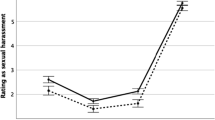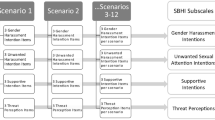Abstract
A laboratory experiment is reported in whichmale participants in Northern Italy (N = 120 universitystudents) were given the opportunity to sendpornographic material to a female interaction partner(“computer harassmentparadigm”). The allegedgender-role orientation of the female (traditional vs.egalitarian) and the construal of the interaction aseither intergroup or interpersonal were variedsystematically. Results show that participants molest femaleinteraction partners more when they express egalitarianrather than traditional gender-role attitudes; this isparticularly true for males with a high propensity to harass (high scores on likelihood of sexualharassment scale, Pryor, 1987), with sexist attitudes,with a strong identification as “males,” andfor low self-monitors. Also, males with a highpropensity to harass were more likely to harass theirinteraction partner when they perceived the situation asa male-female inter-group setting (rather than asinterpersonal). Results are interpreted as supporting a social identity account ofmisogyny.
Similar content being viewed by others
REFERENCES
Abrams, D., & Hogg, M. A. (1988). Comments on the motivational status of self-este em in social identity and intergroup discrimination. European Jo urnal of Social Psych ology, 18, 317–334.
Bargh, J. A., Raymond, P., Pryor, J. B., & Strack, F. (1995). Attractiveness of the underling: An automatic power fisex association and its consequence s for sexual harassment and aggression. Journ al of Perso nality and Social Psych ology, 68, 768–781.
Bem, S. (1984). Androgyny and gender schema theory: A conceptual and empirical integration. Neb raska Symposium on Motivation (pp. 179–226). Lincoln: Unive rsity of Nebaska Pre ss.
Be rsche id, E., Graziano, W., Monson, T., & De rmen, M. (1976). Outcome dependency: Attention, attribution and attraction. Jou rnal of Perso nality an d Social Psych ology, 34, 978–989.
Brannon, R., & Junni, S. (1984). A scale for measuring attitudes about masculinity. Psycho logical Documen ts, 14, 6–7.
Brewe r, M. (1979). In-group bias in the minimal group situation: A cognitive-motivational analysis. Psycho logical Bulletin, 86, 307–324.
Brooks, L., & Perot, A. R. (1991). Reporting sexual harassment: Exploring a predictive model. Psycholo gy of Women Quarterly, 15, 31–47.
Brown, R. (1995). Prejudice. Its social psychology. Oxford: Blackwe ll.
Burt, M. (1980). Cultural myths and supports for rape. Jou rnal of Personality an d Social Psycho logy, 38, 217–230.
Diehl, M. (1990). The minimal group paradigm: theoretical explanations and empirical finding. In W. Stroebe and M. Hewstone (Eds.), Europ ean Review of Social Psycho logy. Chichester: Wiley.
Fitzgerald, L., & He sson-McInnis,M. (1989). The dimensions of sexual harassment: A structural analysis. Journ al of Vocation al Behavior, 35, 309–326.
Fitzgerald, L., Shullman, S. L., Bailey, N., Richards, M., Sweker, J., Gold, Y., Ormeron, A. J., & Weitzman, L. (1988). The incidence and dimensions of sexual harassment in academia and the workplace. Jou rnal of Vocation al Behavior, 32, 152–175.
Fitzgerald, L. F., Swan, S., & Fische r, K. (1995). Why didn’ t she just report him? The psychological and legal implications of women’ s response s to sexual harassment. Special issues: Gende r stereotyping, sexual harassme nt and the law. Jo urn al of Social Issues, 51, 117–138.
Gae rtner, S. L., Mann, J., Murre l, A., & Dovidio, J. F. (1989). Reducing inter-group bias: The benefits of re cate gorization. Jo urn al of Perso nality an d Social Psych ology, 57, 239–249.
Gelfand, M. J., Fitzgerald, L. F., & Drasgow, F. (1995). The structure of sexual harassment: A confirmatory analysis across cultures and settings. Jou rnal of Vocational Beh avior, 47, 164–177
Glick, (1999). Conference of the European Association of Expe rimental Social Psychology, Oxford, July 1999.
Glick, P., & Fiske, S. T. (1996). The Ambivalent Sexism Inventory: Differentiating hostile and benevolent sexism. Jou rnal of Person ality an d Social Psycho logy, 70, 491–512.
Grube r, J. E. (1997). An epidemiology of sexual harassme nt: Evidence from North America and Europe. In W. O'Donohue (Ed.), Sexu al harassment: Theory, research, an d treatmen t (pp. 84–98). Needham He ights, MA: Allyn & Bacon.
Grube r, J. E., Smith, M., & Kauppinen-Toropainen, K. (1996). Sexual harassme nt type s and seve rity: Linking re search and policy. In M. S. Stockdale (Ed.), Sexu al harassmen t in the workplace: Persp ectives, frontiers, and respo nse strategies. Women and work: A Re search and Policy Series, Vol. 5. (pp. 151–173). Thousand Oaks, CA: Sage.
Gutek, B. (1985). Sex and the workplace. San Francisco: Josse y-Bass.
Haavio-Mannila, E., Kaupinen-Toropainen, K., & Kandolin, I. (1988). The e ffect of sex composition of the workplace on friendship, romance and sex at work. In B.A. Gutek, A. H. Stromberg, & L. Larwood (Eds.), Women and work (Vol. 3, pp. 123–138). Beve rly Hills, CA: Sage.
Hinkle, S., & Brown, R. (1990). Intergroup comparisons and social identity: Some links and lacunae. In D. Abrams & M. A. Hogg (Eds.), Social identity theory (pp. 48–70). New York: Harveste r Wheatshe af.
Ickes, W. J., & Barnes, R. D. (1977). The role of sex and self-monitoring in instructured dyadic interactions. Jo urn al of Perso nality and Social Psych ology, 35, 315–330.
ISTATÐ Istituto Nazionale di Statistica (1998). Molestie e violenze sessuali [sexual harassment an d violen ce]. Report by L. L. Sabbadini, Rome, 22 September, 1998.
Judd, C. M., & Park, B. (1988). Out-group homogeneity: Judgme nts of variability and the individual and group levels. Jou rnal of Person ality an d Social Psycho logy, 54, 778–788.
Larwood, L. Szwajkowski, E., & Rose, S. (1988). Sex and race discrimination resulting from manageme nt-client re lationships: Rational bias theory of management discrimination. Sex Roles, 18, 9–29.
Linville, P. W., Fischer, G. W., & Salovey, P. (1989). Perceive d distributions of the characte ristics of in-group and out-group membe rs. Jou rnal of Perso nality an d Social Psycho logy, 57, 165–188.
Long, K. M., & Spears, R. (1994). The influence of personal and collective self-este em on strategie s of social identification. British Jo urnal of Social Psycho logy, 33, 313 – 329. Long, K. M., & Spears, R. (1997). The self-este em hypothesis revisited: Differentiation and the disaffected. In R. Spears, P. J. Oakes, N. Elleme rs, & S. A. Haslam, (Eds.). The so cial psycho logy of stereotyp ing an d grou p life. (pp. 296–317). Oxford: Blackwe ll Publishers
Luthanen, R., & Crocker, J. (1992). A Collective Self-Esteem scale: Self-evaluation of one’ s social identity. Perso nality and Social Psycholo gy Bulletin, 18, 302–318.
Malamuth, N. M. (1989). The Attraction to Sexual Aggre ssion scale: Part one. Jou rn al of Sex Research, 26, 26–49.
Nelson, P. A. (1979). A sexual functions inventory. Unpublished doctoral dissertation, Unive rsity of Florida.
Padavic, I., & Orcutt, J. D. (1997). Pe rceptions of sexual harassme nt ion the Florida legal system: A comparison of dominance and spillover explanations. G en der an d Society, 11, 682–697.
Pryor, J. B. (1987). Sexual harassme nt proclivities in men. Sex Roles, 17, 269–290.
Pryor, J. B. (1992). The social psychology of sexual harassment: Pe rson and Situation factors give rise to sexual harassme nt. In Northwest women’ s Law Center. Sex and power issues in the workplace: An interdisciplinary app roach to un derstan ding, preventing, and reso lving harassment: Conference proceedings (pp. 89–105). Seattle, Washington: Northwest Law Center.
Pryor, J. B., Giedd, J. L., & Williams, K. B. (1995). A social psychological model for predicting sexual harassment. Jo urnal of Social Issues, 51, 69–84.
Pryor, J. B., La Vite, C., & Stoller, L. (1993). A social psychological analysis of sexual harassme nt: The person/situation interaction. Jou rn al of Vocatio nal Beh avior, 42, 68–83.
Pryor, J. B., & Stoller, L. (1994). Sexual cognition proce sse s in men who are high in the likelihood to sexually harass. Person ality an d social Psycho logy Bulletin, 20, 163–169.
Pryor, J. B., & Whalen, N. J. (1997). A typology of sexual harassme nt: Characte ristics of harassers and the social circumstance s under which sexual harassme nt occurs. In W. O'Donohue (Ed.), Sexu al Harassment: Theo ry, Research, an d Treatmen t (pp. 129–151). Needham He ights, MA: Allyn & Bacon.
Rosenberg, J., Pe rlstadt, H., & Phillips, W. R. (1993). Now that we are here: Discrimination, disparagement and harassment at work and the experience of women lawye rs. G en der and Society, 7, 415–433.
Rubinstein, M. (1987). The dignity of women at work.Report on the prob lem of sexual harassment in the member states of the eu ropean commun ities.
Salvadori, (1997). Molestie sessuali nei luogh i di lavoro: Fattori normativi e disposiz ionali [Sexu al harassmen t at work: normative an d dispositional factors]. Unpublished Maste r’ s Thesis, Unive rsitaÁ di Padova.
Savani, N. (1998). La propension e alla molestia sessu ale: Un’ indagin e su studenti universitari [The prop ensity to engage in sexu al harassmen t: A study on un iversity studen ts]. Unpublished Master’ s The sis, Unive rsitaÁ di Padova.
Schwartz Tangri, S., & Hayes, S. M. (1997). Theories of sexual harassme nt. In W. O'Donohue (Ed.), Sexual harassmen t: Theo ry, research, an d treatment (pp. 113–128). Needham He ights, MA: Allyn & Bacon.
Sczesny, S., & Stahlberg, D. (1998). A social prob lem: Sexual harrassment over the ph one. 24th International Congress of Applied Psychology, San Francisco.
Smith, E., Fe re e, M., & Miller, F. (1975). A short scale of attitudes toward feminism. Represen tative Research in Social Psych ology, 6, 51–56.
Snyder, M. (1974). Self-monitoring of expressive behavior. Jo urn al of Person ality and Social Psycholo gy, 30, 526–537.
Snyder, M., & Cantor, N. (1980). Thinking about ourselves and others: Self-monitoring and social knowledge. Journ al of Perso nality and Social Psych ology, 39, 222–234.
Snyder, J., & Gangste ad, S. (1986). On the nature of self-monitoring: Matte rs of asse ssment, matters of validity. Jo urn al of Perso nality and Social Psych ology, 51, 125 – 139.
Snyder, M., & Monson, T. C. (1975). Pe rsons, situations, and the control of social behavior. Jou rnal of Person ality an d Social Psycho logy, 32, 637–644.
Snyder, M., Simpson, J., & Gangste ad, S. (1986). Personality and sexual re lations. Jou rnal of Person ality an d Social Psycho logy, 51, 181–190.
Spears, R., Oake s, P., Ellemers, N., & Haslam, S. A. (Eds.). The social psycho logy of stereotypin g and gro up life. Oxford: Blackwe ll Publishers.
Spence, J. T., He lmreich, R., & Strapp, J. (1973). A short ve rsion of the Attitude Toward Women Scale. Bullettin of Psych onomic Society, 2, 219–220.
Tajfe l, H. (1982). Social psychology of inter-group re lations. Ann ual Rewiew of Psycho logy, 33, 1–39.
Tajfe l, H., & Turner, J. C. (1979). An integrative theory of inter-group conflict. In W. Austin & S. Worchel (Eds.), The social psych ology of inter-gro up relation s, (pp. 33–48). Pacific Grove, CA: Brooks/Cole.
Tajfe l, H., & Turner, J. C. (1986). The social identity theory of inter-group behavior. In W. Austin & S. Worche l (Eds.), The social psycho logy of inter-gro up relation s (2nd ed., pp. 7–24). Chicago: Nelson-Hall.
Turner, J. C., (1982). Towards a cognitive redefinition of the social group. In H. Tajfel (Ed.), Social iden tity an d inter-gro up relations, (pp. 15–41). Cambridge: Cambridge Unive rsity Press.
Turner, J. C. Hogg, M., Oakes, P. J. Re icher, S. D., & Wetherell, M. (1987). Rediscovering the social grou p: A self-categoriz ation theo ry. Oxford: Blackwell.
Zickar, M. J. (1994). Anteceden ts of sexual harassment. Pape r presented at the Society for Industrial/Organizational Psychology Mee ting, Nashville, Tennessee.
Rights and permissions
About this article
Cite this article
Dall'Ara, E., Maass, A. Studying Sexual Harassment in the Laboratory: Are Egalitarian Women at Higher Risk?. Sex Roles 41, 681–704 (1999). https://doi.org/10.1023/A:1018816025988
Issue Date:
DOI: https://doi.org/10.1023/A:1018816025988




